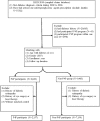Pay for performance program reduces treatment needed diabetic retinopathy - a nationwide matched cohort study in Taiwan
- PMID: 30111370
- PMCID: PMC6094472
- DOI: 10.1186/s12913-018-3454-6
Pay for performance program reduces treatment needed diabetic retinopathy - a nationwide matched cohort study in Taiwan
Abstract
Background: Pay-for-Performance programs have shown improvement in indicators monitoring adequacy and target achievement in diabetic care. However, less is known regarding the impact of this program on the occurrence and long-term effects of diabetic retinopathy. The objective of this study was to determine the effect of pay-for-performance program on the development of treatment needed for diabetic retinopathy in type 2 diabetes patients.
Methods: We conducted a nationwide retrospective cohort study with a matching design using the Taiwan National Health Insurance Research Database from 2000 to 2012. The outcome was defined as the treatment needed diabetic retinopathy. We matched Pay-for-Performance and non-Pay-for-Performance groups for age, gender, year diabetes was diagnosed and study enrollment, and duration of follow-up.
Results: A total of 9311 patients entered the study cohort, of whom 2157 were registered in the Pay-for-Performance group and 7154 matched in the non-Pay-for-Performance group. The incidence of treatment needed diabetic retinopathy was not significantly different in two groups. However, the incidence of treatment needed diabetic retinopathy was significantly different if restricted the non-Pay-for-Performance group who had at least 1 eye examination or optical coherence tomography within 1 year (adjusted hazard ratio, 0.78; 95% confidence interval, 0.64-0.94).
Conclusions: Pay-for-Performance is valuable in preventing the development of treatment needed diabetic retinopathy, which could be attributed to the routine eye examination required in the Pay-for-Performance program. We could improve our diabetic care by promoting eye health education and patient awareness on the importance of regular examinations.
Keywords: Detection bias; Diabetic retinopathy; NHIRD; Pay-for-performance.
Conflict of interest statement
Ethics approval and consent to participate
The personal information of all patients is encrypted, researchers using the NHIRD are required to sign a written declaration and must not gather information that could violate patients’ or care providers’ privacy. Simultaneously, researchers must closely follow the Taiwan Personal Information Protection Act. The hospital Institutional Review Board and Ethics Committee approved this study, which adhered to the tenets of the Declaration of Helsinki; patient consent was not required (VGHKS14-CT3–04).
Consent for publication
Not applicable.
Competing interests
The authors declare that they have no competing interests.
Publisher’s Note
Springer Nature remains neutral with regard to jurisdictional claims in published maps and institutional affiliations.
Figures
Similar articles
-
Synergy between the pay-for-performance scheme and better physician-patient relationship might reduce the risk of retinopathy in patients with type 2 diabetes.J Diabetes Investig. 2021 May;12(5):819-827. doi: 10.1111/jdi.13422. Epub 2020 Nov 7. J Diabetes Investig. 2021. PMID: 33025682 Free PMC article.
-
Does the pay-for-performance programme reduce the emergency department visits for hypoglycaemia in type 2 diabetic patients?Health Policy Plan. 2014 Sep;29(6):732-41. doi: 10.1093/heapol/czt056. Epub 2013 Jul 26. Health Policy Plan. 2014. PMID: 23894069
-
The association between endometrial cancer and subsequent diabetic retinopathy severity: A retrospective nationwide study.Int J Gynaecol Obstet. 2024 Sep;166(3):1313-1322. doi: 10.1002/ijgo.15509. Epub 2024 Apr 2. Int J Gynaecol Obstet. 2024. PMID: 38563816
-
Female breast cancer incidence predisposing risk factors identification using nationwide big data: a matched nested case-control study in Taiwan.BMC Cancer. 2022 Aug 4;22(1):849. doi: 10.1186/s12885-022-09913-6. BMC Cancer. 2022. PMID: 35927682 Free PMC article. Review.
-
Number needed to treat: a useful new method of assessing the magnitude of treatment effect and its application to the management of diabetic retinopathy.Aust N Z J Ophthalmol. 1999 Apr;27(2):137-42. doi: 10.1046/j.1440-1606.1999.00177.x. Aust N Z J Ophthalmol. 1999. PMID: 10379712 Review.
Cited by
-
Changes of Estimated Glomerular Filtration Rate and Glycated Hemoglobin A1c in Diabetic Macular Edema Patients Treated by Ranibizumab and Aflibercept in the Tertiary Referral Hospital.Medicina (Kaunas). 2022 Aug 11;58(8):1081. doi: 10.3390/medicina58081081. Medicina (Kaunas). 2022. PMID: 36013548 Free PMC article.
-
Importance of medication adherence in treatment needed diabetic retinopathy.Sci Rep. 2021 Sep 27;11(1):19100. doi: 10.1038/s41598-021-98488-6. Sci Rep. 2021. PMID: 34580364 Free PMC article.
-
Synergy between the pay-for-performance scheme and better physician-patient relationship might reduce the risk of retinopathy in patients with type 2 diabetes.J Diabetes Investig. 2021 May;12(5):819-827. doi: 10.1111/jdi.13422. Epub 2020 Nov 7. J Diabetes Investig. 2021. PMID: 33025682 Free PMC article.
-
Age, Initial Central Retinal Thickness, and OCT Biomarkers Have an Influence on the Outcome of Diabetic Macular Edema Treated With Ranibizumab- Tri-center 12-Month Treat-and-Extend Study.Front Med (Lausanne). 2021 May 3;8:668107. doi: 10.3389/fmed.2021.668107. eCollection 2021. Front Med (Lausanne). 2021. PMID: 34012972 Free PMC article.
References
MeSH terms
LinkOut - more resources
Full Text Sources
Other Literature Sources
Medical



